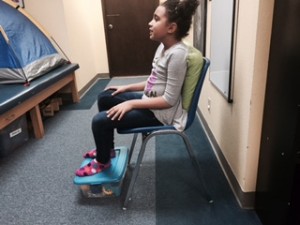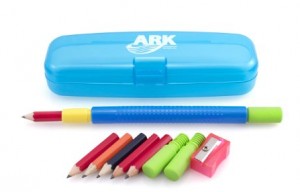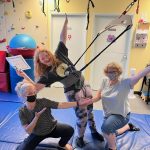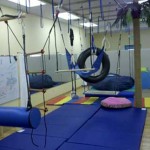At our clinic we see over 100 kids per week with sensory processing disorder. Most of these children have a hard time with the “Big Three Power Senses” of position, movement and touch. Position receptors are in the muscles and joints (proprioception sense) and are activated by joint compression and muscle contraction. Movement receptors (vestibular sense) are located in the inner ear and respond to movement in all directions. Touch receptors are located in our skin. Together the Big Three Power Senses give us a remarkably accurate sense of where our body is in space and allows us to not have to think about our bodies when we are performing higher level tasks such as school work. For example, a 5 yr old should be able to touch the tip of their finger to the tip of their nose with eyes closed within 1 cm. This allows us to go into automatic pilot for everything from sitting to holding a pencil. When children are not getting precise information for position, movement and touch they will seek out information they need (e.g. bouncing, running, touching everything, spinning, pushing, frequently getting up out of their seat, chewing on pencils, crashing into objects or people, and holding a pencil too tightly). There are ways to provide this much needed sensory input to their bodies in productive and non distracting ways which in turn will increase the child’s ability to pay attention and be productive in the classroom.
Sensory Input to increase attention
1) Seating
Most classroom furniture does not fit your students. Start by making sure their feet can touch the floor while their back is supported. If not, provide a pillow behind their back to fill the space (attach it with a T shirt pulled over the pillow and back of the chair) and put something under their feet such as a plastic tub filled with books. The desk should be elbow height (desks are usually adjustable).
Often these changes are enough to provide the sensory input they need to stay in their seat. If not, provide alternate seating such as:
- Exercise band on the front two chair legs allows the child to kick against it and get a lot of resistance to the muscles (and they have to be seated to push against it)
- Move n’ sit cushions allow the child to move in their seat (can also make one with a beach ball partially inflated)
- Exercise ball (can place in a box so it stays put) the vertical bouncing will increase attention
- Rocking chair
- Tennis balls on 2 chair legs to make it wiggle
- Porch swing (Costco has a low profile one)
- Allow students to stand to work (at the counter, or tape work to the wall)
- Allow students to lay down on their tummies to work (also helps with core strength and flexibility)
- Bungee chair
- Office chair for spinning (caution: child needs to spin it themselves and stop if getting dizzy).
2) Table top activities to increase attention
- Figits – (e.g. Koosh ball) busy hands help kids listen better. You can tie them to the desk or chair so if they are thrown they don’t fly. (Caution: stay away from fluid filled balls, usually end up breaking and contents are usually unknown). Click here to make your Ninja ball figit. Chewelry is another great figit helping with students who like to put items in their mouth which helps them focus.
- Write spelling words into play do, modeling clay or silly putty
- Wind up toys
- Kinetic sand (our favorite for easy clean up!)
- Rice bin, find hidden objects
- If your students put things in their mouths you can put it in a zip lock bag (e.g. play do)
3) Physical activity to increase attention– Children were designed to move and not to sit all day. There are many ways to increase movement in your classroom without loosing control of it. 15-20 minutes should be the maximum time spent sitting at a time.
- Include jumping to count or say the alphabet
- Divide worksheets into thirds and when one is done they get up to get the next part
- Include a dance break with some music, even 1-2 minutes can make a big difference
- For the child that needs more have them run an errand (carrying a box of books, pushing or pulling heavy cart to really activate their muscles)
- Classroom chores (washing desks, empty garbage, cleaning white boards)
- Standing desks
- Desk Cycle
- Stand and stretch
- Passing out papers
Sensory Smart Classroom Secrets Part 1 covers changes to the classroom environment to make it more sensory friendly and in Part 3 I will cover tricks for smooth transitions .
Blog Article: Sensory Smart Classroom Secrets Part 1 – Classroom Environment
Blog Article: Sensory Smart Classroom Secrets Part 3 – Transition Tips and Tricks
Next Step:
If you need additional help contact us at (509) 888-7435 or at marykostka@ohanacenter.com to set up a Skype consultation and pay here.
Mary Kostka is a Pediatric Occupational Therapist specializing in Sensory Processing Disorders at her private practice, ‘Ohana Occupational Therapy, LLC, in Wenatchee and Leavenworth Washington, USA She has over 29 years of experience with assisting teachers with making their classrooms sensory friendly.
OhanaOt.com
‘Ohana Occupational Therapy, LLC
1139 N Princeton Suite B
Wenatchee, WA 98801
Ph: 509-888-7435
Fax: 509-888-7674




















Leave a Reply
You must be logged in to post a comment.